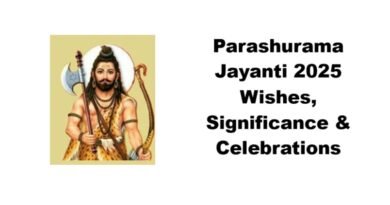
Bohag Bihu 2025: Assamese New Year Celebration, History, and Significance
Introduction
Bohag Bihu, also known as Rongali Bihu, marks the beginning of the Assamese New Year and is the most significant festival in Assam. It is celebrated with great enthusiasm as it symbolizes new beginnings, the onset of spring, and the agricultural season. In 2025, Bohag Bihu will be observed on April 14th and 15th, coinciding with other regional new year celebrations like Pohela Boishakh (Bengali New Year), Vishu (Kerala New Year), and Puthandu (Tamil New Year).
Significance of Bohag Bihu
Bohag Bihu is deeply rooted in Assamese culture and is more than just a new year celebration. It marks the arrival of spring and the harvesting season, bringing joy and prosperity to the farming community. The festival is also an occasion for unity and social harmony, bringing people from all walks of life together in celebration.
1. Agricultural Importance
As Assam is predominantly an agrarian state, Bohag Bihu holds immense importance for farmers. The festival signifies the end of the harvesting season and the beginning of a new agricultural cycle.
2. Cultural Significance
Bohag Bihu is not just about the new year; it is a cultural extravaganza featuring traditional dance, music, feasts, and community gatherings. The famous Bihu dance and Husori songs reflect the vibrant Assamese culture and heritage.
3. Social Significance
Bihu fosters social unity, as it is celebrated by people of all religions, castes, and backgrounds. It is a time for families to come together, mend broken relationships, and welcome the new year with joy and positivity.
History and Origin of Bohag Bihu
The origins of Bihu can be traced back to ancient agrarian traditions, where people would worship the gods for a bountiful harvest. It is believed that Bihu celebrations date back to prehistoric times, with influences from tribal and Indo-Aryan cultures. The word “Bihu” is derived from the Dimasa Kachari language, meaning “excessive joy.”
During the rule of the Ahom dynasty (13th-19th century), Bohag Bihu became an integral part of Assamese culture. The Ahom kings encouraged Bihu celebrations, and over time, it evolved into a festival of great social and cultural importance.
Seven-Day Celebration of Bohag Bihu
Bohag Bihu is a week-long festival, with each day having its own unique significance and customs:
1. Goru Bihu (Cow Bihu) – April 13th
This day is dedicated to cattle, which are an essential part of agriculture. Cows are bathed, decorated, and fed special food as a gesture of gratitude for their contribution to farming.
2. Manuh Bihu (Human Bihu) – April 14th
This is the first official day of the Assamese New Year. People take an early morning bath, wear new clothes, seek blessings from elders, and exchange gifts. Traditional feasts and cultural performances mark the day.
3. Gosai Bihu (Gods’ Bihu) – April 15th
People offer prayers to the gods and goddesses for a prosperous year. Special pujas are performed in homes and temples.
4. Kutum Bihu
This day is dedicated to family reunions and social gatherings. Relatives and friends visit each other’s homes and enjoy traditional Assamese dishes together.
5. Senehi Bihu
A day to express love and affection. Young men and women exchange traditional gifts like gamosas (handwoven cloths) and sweets as a symbol of their love and respect.
6. Mela Bihu
Large fairs (melas) are held in various parts of Assam. These fairs feature folk performances, games, and competitions, drawing people from all over the region.
7. Chera Bihu
The final day of Bohag Bihu, where people reflect on the past year and make resolutions for the new one. It also involves community feasts and concluding celebrations.
Traditional Rituals and Celebrations
1. Bihu Dance and Music
The Bihu dance is one of the most energetic and joyous folk dances of India. Men and women, dressed in traditional Assamese attire, perform this dance to the rhythm of dhol (drum) and pepa (buffalo horn pipe). The songs, known as Husori, are sung in praise of nature and the new year.
2. Bihu Cuisine
No festival is complete without delicious food! Traditional Assamese dishes prepared during Bihu include:
- Pitha (Rice cakes filled with coconut and jaggery)
- Laru (Coconut and sesame sweets)
- Sira-Doi-Gur (Flattened rice, yogurt, and jaggery)
- Masor Tenga (Tangy fish curry)
- Xutuli Pitha (Steamed rice dumplings)
3. Traditional Attire
People wear vibrant traditional Assamese clothes:
- Women wear Mekhela Chador (handwoven silk attire)
- Men wear Gamosa (a handwoven cloth, often gifted as a symbol of respect)
4. Exchange of Gamosa
The Gamosa is an important part of Assamese culture. It is exchanged as a token of love and respect during Bihu.
5. Community Feasts and Fairs
People gather in community halls or open fields to celebrate with feasts, games, and cultural programs. Various traditional sports like buffalo fights and pot-breaking games are also organized.
Modern Influence on Bohag Bihu
With changing times, Bihu celebrations have also evolved. Urban celebrations include Bihu concerts, digital greetings, and online shopping for traditional Assamese outfits. However, the essence of Bohag Bihu remains the same—a celebration of Assamese culture, traditions, and unity.
Conclusion
Bohag Bihu is more than just a festival; it is the heartbeat of Assam’s cultural identity. It brings people together, strengthens traditions, and welcomes a new year with joy, hope, and prosperity. Whether celebrated in the villages of Assam or among Assamese communities worldwide, the spirit of Bihu remains unchanged.
As 2025 approaches, Assamese people across the globe look forward to Bohag Bihu with renewed enthusiasm, cherishing their heritage and welcoming the new year with happiness and positivity.
Bohag Bihu’r Harshita Utsav! (Happy Bohag Bihu!)






